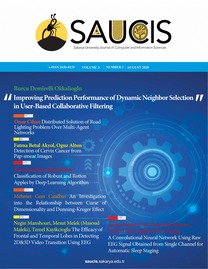On Term Weighting for Spam SMS Filtering
İstenmeyen SMS Filtrelemede Terim Ağırlıklandırma
___
[1] H. Faris, I. Aljarah, and B. Al-Shboul, "A hybrid approach based on particle swarm optimization and random forests for e-mail spam filtering," in International Conference on Computational Collective Intelligence, 2016: Springer, pp. 498-508.[2] R. Varghese and K. Dhanya, "Efficient feature set for spam Email filtering," in 2017 IEEE 7th International Advance Computing Conference (IACC), 2017: IEEE, pp. 732-737.
[3] M. Diale, T. Celik, and C. Van Der Walt, "Unsupervised feature learning for spam email filtering," Computers & Electrical Engineering, vol. 74, pp. 89-104, 2019.
[4] M. A. Shafi’I et al., "A review on mobile SMS spam filtering techniques," IEEE Access, vol. 5, pp. 15650-15666, 2017.
[5] K. O. Kawade and K. S. Oza, "Content-based SMS spam filtering using machine learning technique," International Journal of Computer Engineering and Applications, vol. 7, p. 4, 2018.
[6] T. H. Apandi and C. A. Sugianto, "Analisis Komparasi Machine Learning Pada Data Spam Sms," Jurnal TEDC, vol. 12, no. 1, pp. 58-62, 2019.
[7] S. J. Delany, M. Buckley, and D. Greene, "SMS spam filtering: Methods and data," Expert Systems with Applications, vol. 39, no. 10, pp. 9899-9908, 2012.
[8] J. M. Gómez Hidalgo, G. C. Bringas, E. P. Sánz, and F. C. García, "Content based SMS spam filtering," in Proceedings of the 2006 ACM Symposium on Document Engineering, 2006, pp. 107-114.
[9] G. V. Cormack, J. M. G. Hidalgo, and E. P. Sánz, "Feature engineering for mobile (SMS) spam filtering," in Proceedings of the 30th annual international ACM SIGIR Conference on Research and Development in Information Retrieval, 2007, pp. 871-872.
[10] T. Almeida, J. M. G. Hidalgo, and T. P. Silva, "Towards sms spam filtering: Results under a new dataset," International Journal of Information Security Science, vol. 2, no. 1, pp. 1-18, 2013.
[11] M. T. Nuruzzaman, C. Lee, and D. Choi, "Independent and personal SMS spam filtering," in 2011 IEEE 11th International Conference on Computer and Information Technology, 2011: IEEE, pp. 429-435.
[12] M. B. Junaid and M. Farooq, "Using evolutionary learning classifiers to do MobileSpam (SMS) filtering," in Proceedings of the 13th annual conference on Genetic and evolutionary computation, 2011, pp. 1795-1802.
[13] A. K. Uysal, S. Gunal, S. Ergin, and E. S. Gunal, "A novel framework for SMS spam filtering," in 2012 International Symposium on Innovations in Intelligent Systems and Applications, 2012: IEEE, pp. 1-4.
[14] J. W. Yoon, H. Kim, and J. H. Huh, "Hybrid spam filtering for mobile communication," Computers & Security, vol. 29, no. 4, pp. 446-459, 2010.
[15] H. Najadat, N. Abdulla, R. Abooraig, and S. Nawasrah, "Mobile sms spam filtering based on mixing classifiers," International Journal of Advanced Computing Research, vol. 1, pp. 1-7, 2014.
[16] H.-Y. Lee and S.-S. Kang, "Word Embedding Method of SMS Messages for Spam Message Filtering," in 2019 IEEE International Conference on Big Data and Smart Computing (BigComp), 2019: IEEE, pp. 1-4.
[17] A. K. Jain, S. K. Yadav, and N. Choudhary, "A Novel Approach to Detect Spam and Smishing SMS using Machine Learning Techniques," International Journal of E-Services and Mobile Applications (IJESMA), vol. 12, no. 1, pp. 21-38, 2020.
[18] A. K. Uysal, S. Gunal, S. Ergin, and E. S. Gunal, "The impact of feature extraction and selection on SMS spam filtering," Elektronika ir Elektrotechnika, vol. 19, no. 5, pp. 67-73, 2013.
[19] Y.-T. Chen and M. C. Chen, "Using chi-square statistics to measure similarities for text categorization," Expert systems with applications, vol. 38, no. 4, pp. 3085-3090, 2011.
[20] K. Sparck Jones, "A Statistical Interpretation of Term Specificity and Its Application in Retrieval," Journal of Documentation, vol. 28, no. 1, pp. 11-21, 2004
[21] Y. Liu, H. T. Loh, and A. Sun, "Imbalanced text classification: A term weighting approach," Expert Systems with Applications, vol. 36, no. 1, pp. 690-701, 2009
[22] A. K. Uysal and S. Gunal, "A novel probabilistic feature selection method for text classification," Knowledge-Based Systems, vol. 36, pp. 226-235, 2012
[23] M. Lan, C. L. Tan, J. Su, and Y. Lu, "Supervised and traditional term weighting methods for automatic text categorization," IEEE Transactions on Pattern Analysis and Machine Intelligence, vol. 31, no. 4, pp. 721-735, 2009.
[24] K. Chen, Z. Zhang, J. Long, and H. Zhang, "Turning from TF-IDF to TF-IGM for term weighting in text classification," Expert Systems with Applications, vol. 66, pp. 245-260, 2016
[25] T. Dogan and A. K. Uysal, "Improved inverse gravity moment term weighting for text classification," Expert Systems with Applications, vol. 130, pp. 45-59, 2019.
[26] C.-C. Chang and C.-J. Lin, "LIBSVM: a library for support vector machines," ACM Transactions on Intelligent Systems and Technology (TIST), vol. 2, no. 3, p. 27, 2011.
- ISSN: 2636-8129
- Yayın Aralığı: Yılda 3 Sayı
- Başlangıç: 2018
A Comparison of the State-of-the-Art Deep Learning Platforms: An Experimental Study
On Term Weighting for Spam SMS Filtering
Finding the Relationship Between News and Social Media Users’ Emotions in the COVID-19 Process
Ahmet Anıl MÜNGEN, İrfan AYGÜN, Mehmet KAYA
An Evaluation of VGG16 Binary Classifier Deep Neural Network for Noise and Blur Corrupted Images
Estimation of Constant Speed Time for Railway Vehicles by Stochastic Gradient Descent Algorithm
Automatic Olive Peacock Spot Disease Recognition System Development by Using Single Shot Detector
Energy Saving and Life Cycle Analysis of a Daylight-Linked Control System
Ceyda AKSOY TIRMIKÇI, Cenk YAVUZ
